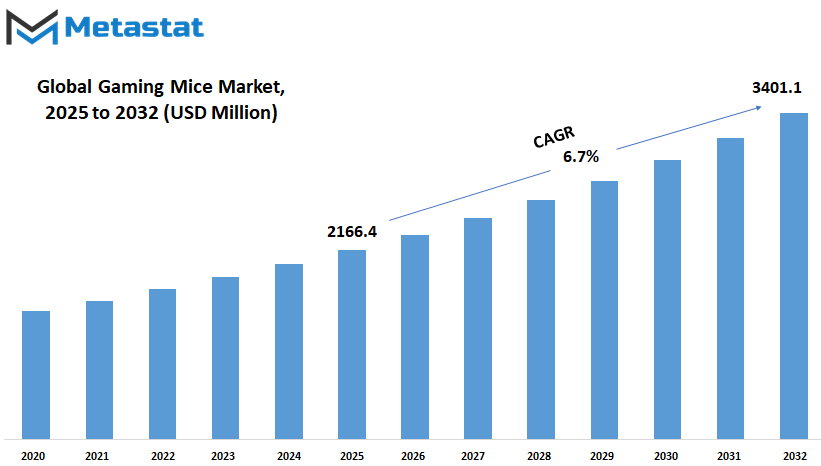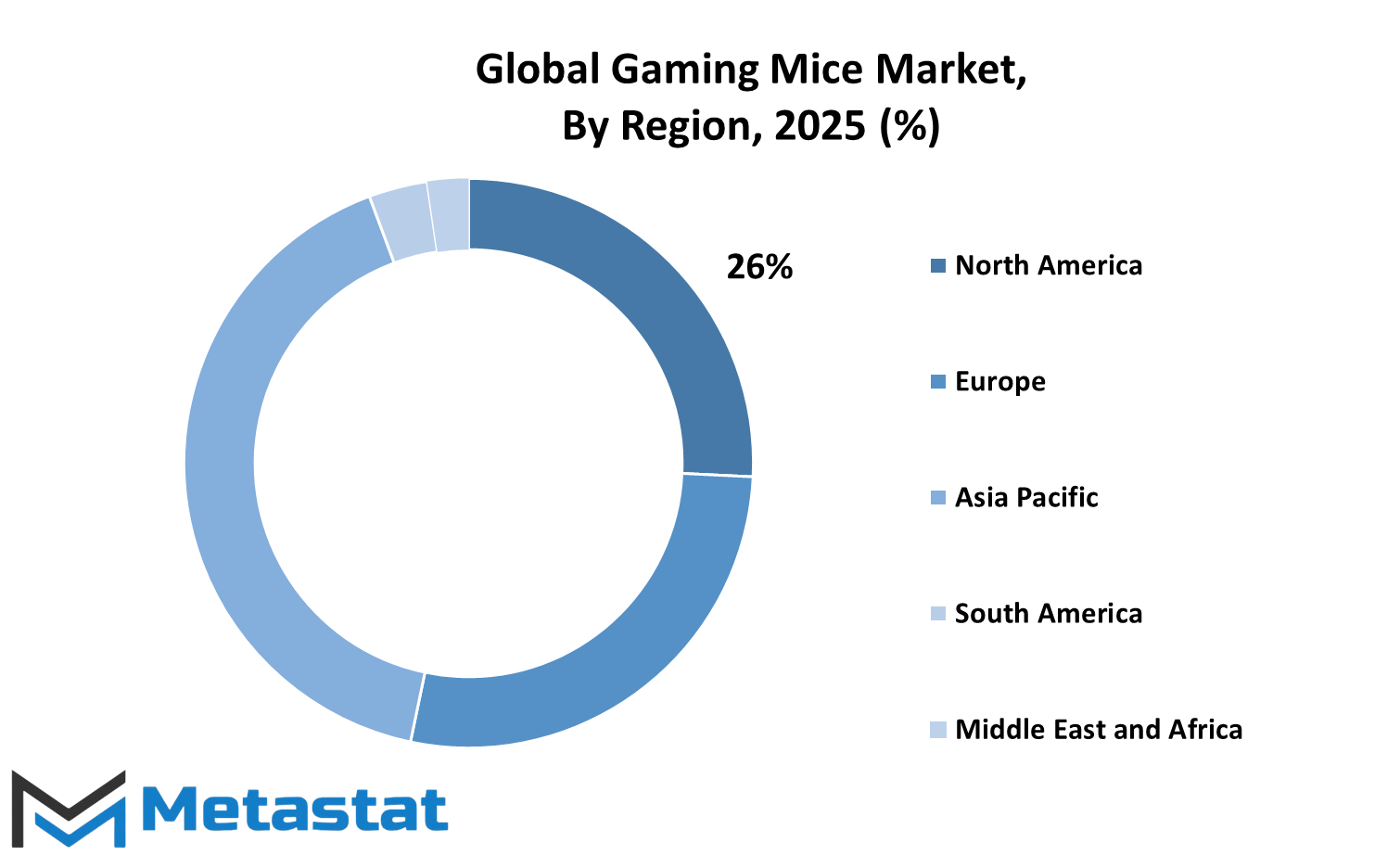MARKET OVERVIEW
The Global Gaming Mice Market and its industry are changing rapidly as technology continues to influence user experiences and performance expectations. The sector caters to professional gamers, casual gamers, and e-sport competitors and places great emphasis on precision, customization, and ergonomics in its design. With gaming capturing the attention of players far and wide, the need for high-performance peripherals such as gaming mice increased tremendously. This area is made all the more diverse by innovation and competition since the market varies across regions, manufacturers, and consumers.
Gaming mice are not just standard peripherals; they are specifically engineered to ensure excellent control, swift responsiveness, and total gameplay immersion. Unlike the traditional computer mouse, a gaming mouse has adjustable DPI, extra programmable buttons, and sophisticated sensor technology. These features enable the player to configure their apparatus to meet particular gaming needs endorsed during e-sports; thus, they are a necessity for it. Brands in this domain still release models that stretch the frontiers of technology so players can have the utmost precision and efficiency.
The center-piece of market trends is customization. Consumers demand highly adaptable products, whether through interchangeable parts, weight management, or infotaining RGB lighting. Some software integration takes this adaptability a notch higher by allowing the users to create genre-specific profiles ranging from First-Person Shooters to Real-Time Strategy Games. The Global Gaming Mice Market incorporates these considerations, with manufacturers focusing on enhancing user experience beyond the hardware and software.
Another huge characteristic of this industry is the e-sports factor. Established competitive gaming has evolved on the ebbs and flow of rapid growth, promoting demand for gear that meets the standards of a professional and disciplined player. Several top brands have closely worked with e-sports teams and influencers to build products that work under the necessities that professional gaming demands. These partnerships have been a great way to build credibility around the product, but they also contribute to informing a casual gamer’s sense of taste when they, too, aspire to use what their favorite players use.
Different connectivity types further characterize the gaming mouse in the market. Wired players still rule the roost with their reliability and low latency; however, the wireless option has come a long way. Enhancements in battery life, charging, and wireless response times have allowed wireless gaming mice to step up as competitors to wired mice. Today, a myriad of gamers pick up their wireless mice without compromising on performance, thus widening the array of products tailored to the taste.
In different regional markets, consumer behavior and brand supremacy pose distinct characteristics. North America and Europe establish the markets with a great demand for high-end gaming peripherals. The Asia-Pacific region is developing into an important center of growth, whereas the fast-rising gaming culture is influencing internet penetration and the growing potential of mobile and PC gaming. These variations urged brands to develop different marketing strategies for each region, distribution of goods, and product development strategies.
As the Global Gaming Mice Market evolves, manufacturers are focusing on refining existing technologies while examining newer possibilities. The further advancement of sensor precision, AI-driven customization, and sustainable materials will be primary consideration areas for product development going forward. The era of immersive, competitive gaming will nonetheless require cutting-edge peripherals to influence the progression of the industry. This market will continue to depend on emerging gaming trends, innovations, and consumer expectations, ensuring that innovation remains the main priority on the agenda for product development.
Global Gaming Mice market is estimated to reach $3401.1 Million by 2032; growing at a CAGR of 6.7% from 2025 to 2032.

GROWTH FACTORS
Slowly, the Global Gaming Mice Market will ride behind the trend of evolving gaming styles and growing audiences in the coming years. The technology advances because gaming mice are one amongst the most demanding accessories to perform at the peak of a game for great gaming experience. New-generation mice for users are coming equipped with precision, comfort, and customization; over a period, these features have become symmetrical in working on such accessories. Companies are on the move to improve sensor accuracy, response time, and ergonomics in devices, which have been making these accessories useful to both amateurs and professionals alike.
The increased popularity of eSports and competitive gaming is perhaps one of the main reasons that lead to the expansion of this market. The surge of tournaments and professional players across the globe is increasing the demand for specialized gaming equipment. Manufacturers are focusing on developing lightweight and highly responsive mice to cater to different styles of gaming for optimal end-user performance. Moreover, the rise of online streaming platforms lures more individuals into gaming and increases demand for gaming mice.
Technological innovation is also a major driving force behind the market. Wireless gaming mice became much more reliable and could give users the same sort of responsiveness as wired models. Improved battery life and charging technology have brought more luster to wireless models for users who prefer the uncluttered approach. Another thing that fueled the increasing demand is the Customization features, such as changeable weights, programmable buttons, and personalized RGB lighting. Such features allow players to use devices with their preferences; thus, they experience more comfort and control when playing.
While the above keeps the market bright and sunny, there are a few factors that could stymie growth. Premium gaming mice typically come at a high price that makes them less accessible to budget consumers, but low-cost alternatives don't always match the performance or the lifetime, which would discourage some gamers. Strangely high costs of raw materials, along with supply chain disruptions, could also disrupt production and may result in delays or hikes in price.
Nevertheless, there remain huge opportunities that could possibly drive the market further in expansion. New possibilities in gaming peripherals open up as more take up cloud gaming and virtual reality. Perfection in cloud gaming will attract many users to high-quality gaming accessories such as mice to bolster this experience. Further evidence for the authorization of the demand for ergonomic and health designs is that they advocate for product design that will reduce strain and discomfort through long gaming activities.
The Global Gaming Mice market will evolve into the future with new technologies and consumer preferences. The long-term success battle will fight against innovation, pricing, and user experience. As games become more mainstream, the demand for high-powered gaming mice will undoubtedly increase, further defining the realm of the future.
MARKET SEGMENTATION
By Product Type
The global market for gaming mice finds itself at a favorably growing position due to video games gaining popularity with an increasing demand for accessories that come in a special class on their own.
Gaming mice are considered tools essential to gamers: in general, these mice offer a set of features including high-precision sensors, customizable buttons, and ergonomically designed shapes that assist and make for enjoyable gameplay. Broadly speaking, gaming mice can be divided into wired and wireless games.
Wired gaming mice have always been the first choice due to their reliable connections and minimum latency, which are critical in fast-paced gaming situations. These connects directly to the computer via cables and provide uninterrupted power and data transfer between the mouse and the computer. The direct physical connection is exactly what attracts professional players, as any form of signal delay during a crucial gaming moment can be fatal.
Wireless gaming mice, on the other hand, have gained fame in the recent past, mainly because of advancements in wireless technology. Present-day wireless products are indeed as good as their wired counterparts and come with a view of freedom, without all the movement restrictions offered by a wire. These include excellent battery life and stable connectivity. Further attractions are the luxury and comfort of having a clutter-free setup as well as the ability to use the mouse from afar.
In the future, the gaming mice market would witness further creativity. Manufacturers would explore advanced technologies like adaptive sensors that change concerning the different surfaces and customizable weight systems. The dimensions of sustainability have gained momentum, and now companies are exploring eco-friendly materials and energy-efficient designs for the fulfilment of the ever-increasing consumer demand for environmentally friendly products.
The esports revolution and competitive gaming are also expected to drive the market. As more and more players enter into professional gaming, the demand for high-performance gaming mice for specific genres will increase. This trend would lead to the production of highly specialized mice for certain types of games, with features that provide an edge in competitions.
The global gaming mice market is expected to go up, and wired as well as wireless segments give unique advantages to satisfy diverse gamer choices. This ever-evolving technological landscape and user-oriented approach will depict the future of such gaming peripherals so gamers will have tools to help them in their gaming exploits.
By Design
Growth in global gaming mice market seems fairly rapid due to popularity of video games increasing among users and the increase in the number of gamers. Of course, such design boasts its importance in the whole market whereby it meets the diversity of requirements of the gamer. Among the major domains is ergonomic gaming mouse designed to provide comfort to users during long periods of time spent in front of a gaming system. These mice are designed to fit the natural contours of the users hand, reducing strain, thus improving control over the harm. As long as someone gives marathon gaming sessions, thereby requiring comfort and easy usability, such designs will witness an upsurge in demand.
Another critical segment falls under the category of ambidextrous gaming mice: these are specially made for left and right users. They also serve very versatile and inclusive aspects. By introducing a symmetrical shape, these mice become a friendlier piece of hardware for gamers worldwide: by using these mice, the gamer can produce results without having to battle with their left or right on the dominance of one hand. As the population of gamers multiplies, so will the requirements for such inclusive designs.
The customizable gaming mouse is another vibrant and modern segment of this fast-evolving market. They are devices that allow users to modify as per his or her needs, weight, button, configurations, and sensitivity settings to adapt to their personal style and requirements for gaming. This DIY enhancement is bound to improve performance and promises to deliver a personalized experience to each gamer. As technology advances, further blistering tailoring-options will be laid before our very eyes in future.
The future gaming mice market will grow at its pace globally. It is a sign that esports is on the rise, sensor technology is improving, and high-performance gaming equipment is becoming widely demanded. It is very likely that these manufacturers' product development efforts will focus on innovative designs that would satisfy the ever-changing needs of gamers. The marketplace will thus remain livelier and competitive.
That makes the future of the gaming mice market promising. Indeed, drawing the future of this market will largely depend on design innovations and trends. As games evolve, so would ergonomic, ambidextrous, and customizable designs evolve to enhance user experience and accommodate the tastes and preferences of gamers all over the world.
By Sensor Type
It is observed that the gaming industry has grown well in the past few years, which has increased the demand for certain specialized peripherals, one of the most important of which is gaming mice, required by gamers for precision and enhanced performance. Another critical feature of gaming mice is their sensors, with optical and laser sensors almost standing as the only alternatives.
In gaming mice, optical sensors use LED light to register movement. They are highly accurate and can be used on all surface types. This greatly supplements the use of optical sensors in fast-action games where speed and accuracy are required. Optical sensors are used wherever there is a need for precision tracking and otherwise a cheaper option.
On the contrary, laser sensors use laser light for mode detection, thereby offering higher sensitivity and greater DPI settings; this means better precision and responsiveness. Laser sensors work on a larger variety of surfaces, such as glossy or reflective surfaces, that optical sensors may struggle with. However, generally, laser sensors are priced higher, which can sway the judgment of a gamer on which mouse to settle for.
As we look into the future, the gaming mice market will increasingly witness a surge of activity. Given the advancement in technology, one can expect to see much more improvement in optical and laser sensor technology. Once again, improvement would be in terms of the ability, speed, and power efficiency. We also expect such manufacturers to develop adaptive sensors for varied gaming environments and keyboards or surfaces, thus providing gamers with wider and reliable options.
With the option to choose from a host of advanced high-performance gaming mice equipped with the latest in sensor technology fast finding favor, with players who are getting turned to competitions, this will keep driving the demand higher. Players are demanding more from peripherals and expect them to help in making performing where they have an edge. This will motivate manufacturers to innovate and put into use features that are specific to the demands of professional as well as amateur players.
In conclusion, the global gaming mice market appears bright because the development of new sensors will always remain a key factor as far as its future is concerned. Both optical and laser sensors do have their advantages, and in the near future, their further betterment will be the focus of advancement. As the gaming industry is going to keep expanding, demands will arise for next-gen gaming mice in unison with the latest sensor technology that will enable gamers to get more performance and immersiveness.
By End User
As gaming concludes its refinement, varied entries from backgrounds are being attracted, thereby promoting the bigger growth. The increases in e-sports activities and the setting up of casual gaming communities are helping in the very growth. As technology advances, gaming mice themselves are getting more and more modernized with newer features like great precision, very fast response, and customizability for gamers of all sorts. With the rise of gaming, the need for superior-performing peripherals may escalate, compelling manufacturers to make the most out of their innovative designs and enhanced functions.
In this view, the market is segmented into two primary divisions based on users: “professional gamers and casual gamers.” Professional gamers operate in an extremely competitive environment, and to optimize their performance, they require high-end gaming mice equipped with precision sensors, adjustable weight systems, and programmable buttons. In competitive gaming, precision and speed matter; the smallest delay can tip the scales. Companies are launching models based on new technologies to satisfy these needs. Once an issue in wireless gaming mice, latency has been resolved by improved connectivity and battery life. Ergonomics and customizable settings keep professional gamers a step ahead in tournaments and intense gaming sessions.
Casual gamers, however, will opt for gaming mice offering an equilibrium between performance and price. While inexpensive gaming mice may not have the features available in professional-grade models, the models still need to be comfortable and responsive. Many casual gamers prefer plug-and-play with some basic customization rather than spending time setting the mouse up to their liking. As accessibility to gaming widens, from cloud gaming to mobile devices, manufacturers have worked on developing gaming mice that are compatible across most of the systems.
Considering the future, the Global Gaming Mice market would feature more developments in AI, adaptive ergonomics, and cloud customization. AI gaming mice would be able to analyze user behavior and automatically modify the mouse sensitivity or button mapping in order to give the best possible experience without needing the user to do any manual work. Ergonomics are fast, being made keeping in mind different sizes of hands and grip styles and working toward reducing strain after long hours of usage. Cloud-based customization may enable players to save their settings and sync them across all devices, giving them the freedom to swap between different platforms without resetting their entire configuration.
Sustainability has come into focus, and companies are testing eco-friendly materials and energy-efficient parts. With the mounting stress towards ecological problems, these consumers will be looking for gaming mice that resonate with their conscience without any compromise to performance. Thus, the Global Gaming Mice market will continue to evolve, driven by innovation, competition, and shifting consumer preferences. The growth of gaming peripherals will follow technologies that enhance the certainly pleasing aspects of the games while also offering comfort and convenience to a diverse audience.
|
Forecast Period |
2025-2032 |
|
Market Size in 2025 |
$2166.4 million |
|
Market Size by 2032 |
$3401.1 Million |
|
Growth Rate from 2025 to 2032 |
6.7% |
|
Base Year |
2024 |
|
Regions Covered |
North America, Europe, Asia-Pacific, South America, Middle East & Africa |
REGIONAL ANALYSIS
The biggest contributors are states like the USA, Mexico, and Canada. Although the above defines the market development of the region, it is the great culture of gaming in conjunction with high-income that can tremendously push demand for the superior gaming peripherals. The above factors are coupled with other aspects linked to esports and the competitive spirit among gamers who would want high-grade equipment for an impressed competitive taking-off.
Europe, which has got countries like the UK, Germany, France, and Italy, has a direct contribution to the gaming mouse market. Due to the rich heritage regarding gaming and the adoption of technology, the market has been reinforced by the region concerning gaming peripherals. The growth in the use of esports is expected to be followed by an increased demand for specific gaming mice in Europe, which will serve both casual gamers and competitive professional esports athletes alike.
The region encompassing India, China, Japan, and South Korea is one of the fastest developing areas in terms of gaming. The huge population opened up a market that with a growing number of people interested in gaming is meeting a great demand for gaming mice in the very near future. Nations such as China and South Korea have already emerged as global gaming hubs, pushing the consumption of gaming peripherals to a considerable level. Thus, with increasing income and more mainstream gaming, the whole of the Asia-Pacific is expected to develop very good potential for a gaming mouse market.
In South America, the surge in gaming activities is being experienced in countries like Brazil and Argentina. The recent boom in the popularity of esports and increasing access to gaming platforms coupled with the phenomenon above have contributed to increased demand for gaming equipment, especially mice. As these countries have formed extensive gaming communities, newer and potentially eager customers should be available for manufacturers to cater to.
The region of the Middle East & Africa, consisting of the GCC countries, Egypt, and South Africa, is now starting to develop as a real potential market for gaming mice. These countries are comprised of young people mostly above 70% and are at the stage where more than 40% of the population have access to the Internet. Gaming is becoming increasingly popular as a type of entertainment. With the development of gaming culture, we are seeing a rising market in the demand for gaming peripherals for casual and competitive gamers alike.
The future seems bright for the global gaming mouse segment as it shows promise for growth throughout the regions. These include development in technology, escalations in esports, and increases in disposable incomes. Most importantly, manufacturers who pay attention to innovations and regional demands will find themselves well-positioned to take advantage of the unique opportunities presented by this dynamic market.

COMPETITIVE PLAYERS
The global gaming mice market has witnessed fast development in recent years owing to the increasing popularity of video games and the growth of esports. Companies such as Logitech, Razer Inc., Corsair Gaming, and SteelSeries have pioneered the design and manufacture of innovative products for amateur and professional gamers alike. Such companies have fully focused on developing high-performance mice, which incorporate advanced features such as customizable buttons, high-precision sensors, and ergonomic designs to provide an enhanced gaming experience.
The gaming mouse market will likely continue to follow an upward trend. With the growth in technology, advanced features shall be incorporated, such as better wireless connectivity, more battery hours, and enhanced options for customization. Engaging in research and development towards producing more precise, comfortable products that meet the changing needs of gamers is also most likely in the market.
Through the continuous innovation and partnership offerings through technology, the competitive environment of the gaming mouse market exists. Major market players are expected to continue investing in expanding their product offerings as well as improving the global presence of these offerings through potential collaborations with esports teams and gaming influencers as they fulfill a role in reaching out more effectively to obtain a broader audience.
It is very likely that the global gaming mice market will continue to prosper in the coming years as new technology is developed and gaming becomes increasingly popular. Firms concentrating on innovation and being attuned to the gamers’ real needs shall possess a momentous lead over other players existing in the dynamic environment.
Gaming Mice Market Key Segments:
By Product Type
- Wired Gaming Mice
- Wireless Gaming Mice
By Design
- Ergonomic Gaming Mice
- Ambidextrous Gaming Mice
- Customizable Gaming Mice
By Sensor Type
- Optical Sensors
- Laser Sensors
By End User
- Professional Gamers
- Casual Gamers
Key Global Gaming Mice Industry Players
- Logitech
- Razer Inc.
- Corsair Gaming, Inc.
- SteelSeries
- ASUSTeK Computer Inc.
- HyperX (HP Inc.)
- Zowie (BenQ)
- Cooler Master Technology Inc.
- Turtle Beach Corporation
- Mad Catz Global Limited
- MSI (Micro-Star International Co.,Ltd.)
- Glorious LLC
- Cougar. Compucase Enterprise Co., Ltd.
- Thermaltake Technology Co., Ltd.
- EVGA Corporation
WHAT REPORT PROVIDES
- Full in-depth analysis of the parent Industry
- Important changes in market and its dynamics
- Segmentation details of the market
- Former, on-going, and projected market analysis in terms of volume and value
- Assessment of niche industry developments
- Market share analysis
- Key strategies of major players
- Emerging segments and regional growth potential








 US: +1 3023308252
US: +1 3023308252






